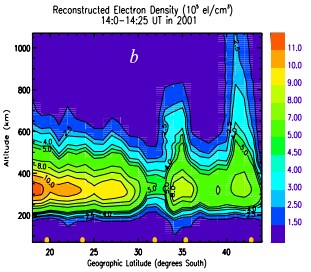
TID = Travelling Ionospheric Disturbance
Using Tomographic Reconstruction of GPS data
To the left are ionspheric electron density obtained by reconstruction of GPS data recorded during successive time periods on November 6, 2000. What is plotted is the computed electron density colour coded using the scheme to the right at each panel at height up to 1000km against the geographic latitude (south). Because of data gathering issues data for each ionospheric reconstuction is gathered over a 25 minute Universal Time (UT) range as follows:
- a UT 1300-1325
- b UT 1400-1425
- c UT 1430-1455
- d UT 1630-1655
From page 162 of Endawoke Yizengaw's PhD thesis, Imaging the Ionosphere submitted 29/10/2004 to La Trobe University

